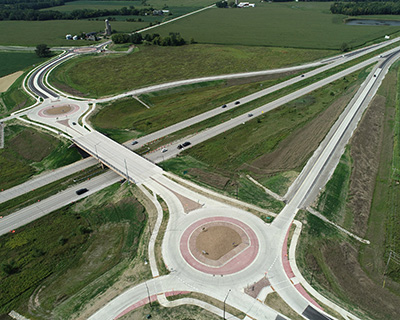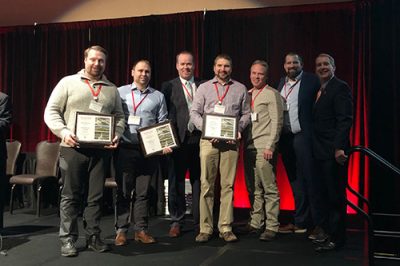STH 29/CTH “VV” Interchange Wins WisDOT Construction Award

The STH 29/CTH “VV” Interchange project in Brown County this week was awarded the 2022 Outstanding Highway Construction Award from the Wisconsin Department of Transportation in the category of grading for contracts of $25 million and under.
Hoffman Construction Company, Inc., was the prime contractor on the WisDOT Northeast Region project, and Ayres was the design engineer and assisted WisDOT with construction engineering for the new diamond interchange about 0.3 mile west of the former STH 29/CTH “VV” at-grade intersection, which had been the scene of several serious crashes. The at-grade intersections at CTH “VV” and the nearby CTH “U” were closed as part of this project.
The interchange connects with Marley Street to the north and CTH “VV” to the south. Roundabouts were constructed at the STH 29/CTH “VV” eastbound ramp terminus and the STH 29/Marley Street westbound ramp terminus. Three stormwater detention ponds were constructed to improve stormwater quality.
The application for the award stated: “This project is a great example of what can be accomplished by a contractor and engineering staff working cooperatively, taking pride in workmanship, having the foresight to anticipate and manage issues, and having exceptional communication at all levels.”

Constant communication with WisDOT, Brown County, the Village of Hobart, the Village of Howard, the Town of Pittsfield, and the Oneida Nation kept the grading operations on schedule. Construction began in May 2021 and was completed in October 2022.
Construction challenges included poor soil conditions, the high groundwater table, and Green Bay’s third-wettest summer on record in 2021, including 8.3 inches of rain in August alone.
To address the poor soils in the area, this contract called for excavating below sub-grade and placing Geotextile Type SAS, 2 feet of select crushed material, and 2 feet of select borrow material.
Watersheds impacting Trout Creek and Lancaster Creek – environmentally sensitive areas for the Oneida Nation – were diligently protected by controlling runoff and dewatering the construction site, ensuring clean water was leaving the project.
